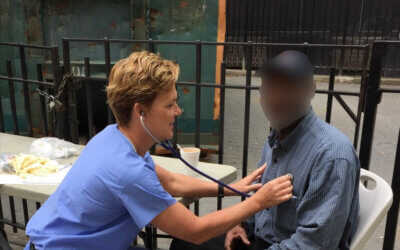Raising Cervical Cancer Awareness
Find out how cervical cancer awareness has grown drastically in the last 20 years & why the U.S. government designated January to help educate.
 With the advent and increase in usage of Pap tests, the cervical cancer death rate decreased dramatically due to much earlier diagnoses.
With the advent and increase in usage of Pap tests, the cervical cancer death rate decreased dramatically due to much earlier diagnoses.
Today we continue “DRops of Wisdom,” our physician blog, with Dr. Ron Schonwetter, chief medical officer for Chapters Health System. He describes the importance of raising cervical cancer awareness during the month of January.
January is Cervical Cancer Awareness Month
Over the last two decades, awareness of cervical cancer has grown significantly. This is due in large part to the National Cervical Cancer Coalition, whose mission is to help women, family members and caregivers battle the personal issues related to cervical cancer and promote prevention through community education. Subsequently, the U.S. government designated the month of January to also raise awareness about this form of cancer.
According to the American Cancer Society, approximately 13,240 new cases of invasive cervical cancer will be diagnosed and about 4,170 women will die from cervical cancer in the United States in 2018. Today, cervical pre-cancer is identified more often than the invasive form of cervical cancer.
Years ago, cervical cancer was one of the most common types of cancer that resulted in death for women in the United States. With the advent and increase in usage of Pap tests, the cervical cancer death rate decreased dramatically due to much earlier diagnoses.
How has this screening test helped? Before cancer even starts to develop in the cervix, a Pap test can recognize subtle changes. And if cervical cancer has started to evolve, this screening test identifies the change earlier on, when it’s easier to treat and cure. In 1971 when President Nixon signed the National Cancer Act and introduced the federal mandate “war on cancer,” the five-year survival of women with Stage 0 cervical cancer was less than 50 percent compared to 93 percent today.
Who is At Risk?
Women between the ages of 35 and 54 are most at risk for developing cervical cancer. It is rare in women younger than 20. Nevertheless, older women need to understand that they aren’t without risk as well. In fact, the percent of new cases of cervical cancer in women over the age of 65 is almost 20 percent of all new cases diagnosed.
In looking at ethnicity, Hispanic women are the population with the highest rates of cervical cancer. They are followed by African Americans, Caucasians and Asians.
What predisposes a woman toward cervical cancer? There are several risk factors that can increase a woman’s risk in developing this form of cancer.
Risk factors are:
- Human papillomavirus (HPV): Over the last couple of years, there has been an increase in spreading the word about this most important risk factor for cervical cancer. Some individuals who are not able to rid their body of HPV develop a chronic infection, which greatly increases their risk of developing cervical cancer.
- Weak immune system: As with other forms of cancer, a weak immune system puts individuals at high risk due to the fact that the body isn’t able to destroy or curtail the growth and spread of cancer cells or infections such as HPV. For example, cervical pre-cancer can rapidly become invasive in a woman who also has HIV.
- Smoking: Any woman who smokes tobacco puts herself at almost double the risk of developing cervical cancer. Studies have demonstrated that the by-products of tobacco damage the DNA in the cervix. Smoking also can weaken the immune system in fighting HPV infections.
- Chlamydia: This common bacterial infection gravitates to a woman’s reproductive organs. Like HPV, this infection is spread via sexual contact and most women do not experience any symptoms. According to a study published in JAMA, research confirmed a high risk of cervical cancer in women who had past or current chlamydia infections, which were then verified by blood tests and cervical mucus.
- Family history: As with breast cancer, a mother or sister with cervical cancer increases a woman’s chance of developing this disease. This may be due to a family tendency to inherit the inability for women to fight off HPV infections.

Dispelling 3 Cervical Cancer Myths
In our society, there always seem to be various topics that are fraught with myths and misconceptions. So today, we are tackling the topic of cervical cancer and setting the record straight.
Myth #1: Cervical cancer can’t be treated.
If detected and diagnosed early, cervical cancer can be treated effectively. Thus, it is very important to have routine preventive screenings even if no symptoms are present.
Myth #2: Older women don’t need Pap smears.
All women, who are 21 years or older, need periodic and regular Pap smears until the age of 65. After that age, women should discuss with their physicians the risks and benefits of ongoing screening based on their specific circumstances.
Myth #3: The Human papillomavirus (HPV) infection is not common.
HPV is common and the most important risk factor for developing cervical cancer. It is transmitted via skin-to-skin contact and bodily fluids. It is estimated that approximately 80 percent of Americans will contract HPV sometime during their lifetime. Oftentimes, people don’t experience any HPV symptoms, such as visible genital warts, and thus may never know they had/have HPV. Women learn that they contracted HPV when their screening test comes back positive. An abnormal Pap test can be related to HPV, but many times physicians don’t relay this information to their female patients. Therefore, many women do not know or understand the link between HPV and cervical cancer.
A vaccine to prevent HPV was first developed in 1991 by researchers Ian Frazer and Jian Zhou at the University of Queensland. It was then patented in the United States, and introduced as a tactic to combat HPV spread by the Centers for Disease Control (CDC). Today the CDC recommends that the vaccine be given to preteen girls and boys at age 11 or 12. The reasoning behind this recommendation is that these children will be protected before ever being exposed to HPV. This vaccine is actually a series of two vaccines given six to twelve months apart. If given over age 14, three shots are needed over a six month period.
Discover more details and information about care for patients with cancer.
For more information, please call our helpful Chapters Health and HospiceHelp24® team at 1.866.204.8611 or Contact Us.
Keep Exploring
















